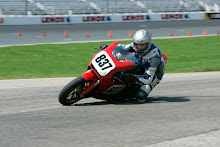
Working on the last post, "Rip Van Lockwire", looking through my files for the pic I had just uploaded from the camera, I came across the pic at left. It's my little TT2, of course, but a lot seems to be missing. Other than the obvious, like the bodywork and fuel tank, let's see. . . no cam belt tensioners (the bearings were crunchy), no rear brake reservoir, no rear shock (although the stock rear shock on many Ducatis bears a lot of resemblance to the custom job seen here). There's still street-bike switchgear on the left handlebar. What you can't see is that there's no rear brake setup at all, no caliper, hanger, or brake stay. No race tires. No catch bottles for fluids. No lockwiring. The reason this photo caught my eye, however, was the date stamp: 2008_05_10. Saturday, May 10th, 2008. My first race ever was Saturday, May 17th, 2008, seven days later. The evening before, I had been over at Bruce's, and he had helped me adapt a modern 4.5" Ducati wheel to replace the 5.5" Buell wheel that someone had grafted on. . . it made the bike nearly impossible to turn, and besides, the bearings were bound up and the wheel was turning on the aluminum bushings that had been made to adapt it to the small Verlicchi axle. We also converted to a 520 final drive using Ed Milich's marvelous little countershaft sprocket, and put on a lovely gold chain and alloy rear sprocket. Bruce lent me a rear caliper, and on Saturday, the day this pic was taken, I found someone on ducati.ms who was parting out a 900SS/SP, and still had the full-floating rear brake setup. I got him to send it out Priority Mail, and it arrived on Wednesday.
All this fun actually started on April 15th. I had bought the TT2 back in September 2007 because, well, because I just had to have it. I'd been wanting one ever since I saw a tiny, elegant bare frame sitting on a shop floor five years before. I had no intention of racing, not me. Mary spent the winter building an RD400 racebike, but I just wasn't interested. Mary was scheduled to go to a race school on April 15th so she could qualify for a license. . . but the school was cancelled, probably because there was still snow on the track. They rescheduled for May 16th, and I thought, well, why not? So, I went out to the trailer, and threw open the ramp door to tell my little TT2 we were going racing. . . and then I noticed that the rear wheel was sitting in a pool of oil. The rear shock seal had blown. My memory refuses to inform me what it cost to ship that Works Performance shock to California, get it rebuilt, and have it get back to me in time to make that first race. . . especially since I found out a few days later that my friend Eric Colbath of Clubhouse Motorsports could have done the work for me locally, and probably even better than the factory.
Ah yes, innocence. I never would have believed how much handwork (not to mention time sitting, looking, thinking) goes into getting a bike, especially a kit bike like the TT2, ready for its first race. . . especially since it was my first race as well. There was very little sleep that week, and probably neither of us- me or the TT2- should have been out there on the track. As Gil Greenlaw told Betty Bluenose over the walkie-talkie, when I headed up over the hill to Turn 6 rather than go through 3-10 as she'd signaled me, "Let her go, she probably can't even see you!" And my TT2? Well, it's a good thing I never use the rear brake on the track. Late in the season, I traced the little chattering noise from the rear end to the brake pads. . . one of which was carefully pinned and wired in backwards, probably at 3:00AM one of those nights.






